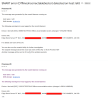Yesterday while I was doing something, I got an email notifcation from my proxmox cluster saying that my second node, an R720 filled to the top with 2.5 SSD's, had failing drives. Upon opening said email, I saw this:

This wasnt the only email I got, too, it showed other drives like /dev/sdg, /dev/sda, /dev/sdh, and alot of the 240 GB drives (not sure if it showed any of my 940 GB ssd's), and the sector count it showed seemed absurdly high. (216 trillion sectors??)
Is proxmox reading my drives SMART data correctly? Are all of my drives failing? This server was bought used as well as the drives, but the wearout is 100% in proxmox hasnt dropped, so I assume theyre fine. I feel like this is a reading error, because I recently got 2 ironwolf hard drives brand new in a different server and they showed immediately as bad, but I found out proxmox was reading the data bad, but I dont know if thats the case or not here. If it is, is there a way to make proxmox read it correctly?
I also ran multiple smart command tests yesterday on the drives and they reported back as passed.
Here is a video of what one of the drives S.M.A.R.T data looks like in proxmox:
https://cdn.meemkade.com/u/36378530-eb42-499a-b6f2-d8d6df5408ad.mp4
The ZFS pool the drives are in also shows them all as OK and it hasnt degraded.

This wasnt the only email I got, too, it showed other drives like /dev/sdg, /dev/sda, /dev/sdh, and alot of the 240 GB drives (not sure if it showed any of my 940 GB ssd's), and the sector count it showed seemed absurdly high. (216 trillion sectors??)
Is proxmox reading my drives SMART data correctly? Are all of my drives failing? This server was bought used as well as the drives, but the wearout is 100% in proxmox hasnt dropped, so I assume theyre fine. I feel like this is a reading error, because I recently got 2 ironwolf hard drives brand new in a different server and they showed immediately as bad, but I found out proxmox was reading the data bad, but I dont know if thats the case or not here. If it is, is there a way to make proxmox read it correctly?
I also ran multiple smart command tests yesterday on the drives and they reported back as passed.
Here is a video of what one of the drives S.M.A.R.T data looks like in proxmox:
https://cdn.meemkade.com/u/36378530-eb42-499a-b6f2-d8d6df5408ad.mp4
The ZFS pool the drives are in also shows them all as OK and it hasnt degraded.



